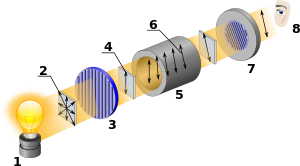الدوران النوعي

الدوران النوعي specific rotation لمركب كيميائي [α] يـُعرَّف بأنه الزاوية المرصودة للدوران الضوئي α عندما يمر ضوء مستقطب على مستوى عبر عينة بمسار طوله 1 دسيمتر ويكون تركيز العينة 1 گرام لكل 1 مليلتر. الدوران النوعي لمادة نقية هو خاصية داخلية لتلك المادة عند طول موجي ودرجة حرارة محددان. القيم يجب أن تـُرفق بدرجة الحرارة التي تم القياس فيها والمذيب الذي انحلت المادة فيه. كثيراً ما يـُغفل ذكر درجة الحرارة؛ وفي تلك الحالات يـُفترض أنها درجة حرارة الغرفة. الوحدة الرسمية لقيم الدوران النوعي هي deg dm-1cm3 g-1 إلا أن الكتابات العلمية تستخدم مجرد الدرجة. القيمة السالبة تعني دوران ضد عقارب الساعة والقيمة الموجبة تعني دوران مع عقارب الساعة. وفيما يلي بعض الأمثلة:
- سكروز +66.47°
- لاكتوز +52.3°
- كولسترول −31.5°
- Camphor +44.26°
- پنيسلين V +223°
- تاكسول −49°
- (S)-bromobutane +23.1°
- (R)-bromobutane −23.1°
- (+)-cavicularin +168.2°
القياس
| اسم المركب | [α]D20 [deg dm−1 cm3 g−1] |
|---|---|
| (S)-2-Bromobutane | +23.1° |
| (R)-2-Bromobutane | −23.1° |
| D-Fructose | −92°[1] |
| D-Glucose | +52.7°[1] |
| D-Sucrose | +66.37°[1] |
| D-Lactose | +52.3°[1] |
| Camphor | +44.26°[1] |
| Cholesterol | −31.5°[1] |
| Taxol A | −49°[2] |
| Penicillin V | +223°[3] |
| Progesterone | +172°[4] |
| Testosterone | +109°[4] |
| (+)-Cavicularin | +168.2°[5] |
| Hexol bromocamphorsulphonate | 2640°[6] |
Optical rotation is measured with an instrument called a polarimeter. There is a linear relationship between the observed rotation and the concentration of optically active compound in the sample. There is a nonlinear relationship between the observed rotation and the wavelength of light used. Specific rotation is calculated using either of two equations, depending on whether the sample is a pure chemical to be tested or that chemical dissolved in solution.
للسوائل النقية
هذه المعادلة هي المستخدمة:
In this equation, α (Greek letter "alpha") is the measured rotation in degrees, l is the path length in decimeters, and ρ (Greek letter "rho") is the density of the liquid in g/mL, for a sample at a temperature T (given in degrees Celsius) and wavelength λ (in nanometers). If the wavelength of the light used is 589 nanometers (the sodium D line), the symbol “D” is used. The sign of the rotation (+ or −) is always given.
- °
للمحاليل
For solutions, a slightly different equation is used:
In this equation, α (Greek letter "alpha") is the measured rotation in degrees, l is the path length in decimeters, c is the concentration in g/mL, T is the temperature at which the measurement was taken (in degrees Celsius), and λ is the wavelength in nanometers.[7]
الاستخدامات
Enantiomeric excess
If the specific rotation of a pure chiral compound is known, it is possible to use the observed rotation to determine the enantiomeric excess (ee), or "optical purity", of a sample of the compound, by using the formula:[8]
الهامش
- ^ أ ب ت ث ج ح R. C. Weast (1974). Handbook of Chemistry and Physics (55th ed.). CRC Press.
- ^ "The Merck Index Online: Paclitaxel". Royal Society of Chemistry. Retrieved 30 June 2014.
- ^ "The Merck Index Online: Penicillin V". Royal Society of Chemistry. Retrieved 30 June 2014.
- ^ أ ب Paula Yurkanis Bruice (2012), Organic Chemistry, Pearson Education, Limited, p. 163, ISBN 978-0-321-80322-1, http://books.google.com/books?id=B7t1MAEACAAJ
- ^ M. Toyota; et al. (1 July 1996). "(+)-Cavicularin: A novel optically active cyclic bibenzyl-dihydrophenanthrene derivative from the liverwort Cavicularia densa Steph". Tetrahedron Letters. Elsevier. 37 (27): 4745–4748. doi:10.1016/0040-4039(96)00956-2. Retrieved 26 June 2014.
{{cite journal}}: Explicit use of et al. in:|author=(help) - ^ A. Werner "Über mehrkernige Metallammoniake" Chem. Ber. 1907, volume 40, pp. 2103–2125. doi:10.1002/cber.190704002126
- ^ P. Y. Bruice (2011). Organic Chemistry (Sixth ed.). Prentice Hall. pp. 209–210.
- ^ خطأ استشهاد: وسم
<ref>غير صحيح؛ لا نص تم توفيره للمراجع المسماةsundberg
![{\displaystyle [\alpha ]_{\lambda }^{T}={\frac {\alpha }{l\times \rho }}}](https://wikimedia.org/api/rest_v1/media/math/render/svg/ead9c29d557c3062adcb985a4e942a39e67e49a4)
![{\displaystyle [\alpha ]_{D}^{20}+6.2}](https://wikimedia.org/api/rest_v1/media/math/render/svg/e922a8c4ffaa0cf49c19711c78ac539dfa1e4c0e)
![{\displaystyle [\alpha ]_{\lambda }^{T}={\frac {\alpha }{l\times c}}}](https://wikimedia.org/api/rest_v1/media/math/render/svg/e205459452ac5bd68f45ac74c932c84f6ac5b6df)
![{\displaystyle ee(\%)={\frac {\alpha _{\text{obs}}\times 100}{[\alpha ]_{\lambda }}}}](https://wikimedia.org/api/rest_v1/media/math/render/svg/bd195194f1f12dcc6a42795e2986b0ec99e84259)